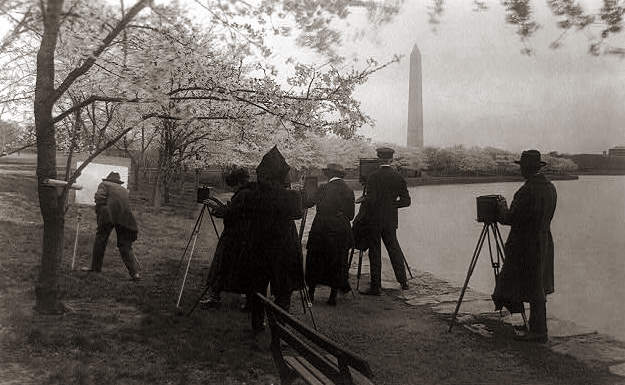The more famous, American Cherry Blossom Festival commemorates the effort by Japan to draw close to the West by extending an offer of friendship to the United States in 1912. While the West, a block of racist nations snubbed Japan, whom the White supremacist leadership of the US then considered “funny looking Asian people”, a rebuff that made the Land of the Rising Sun dump the allies of the First World War and join the Axis Powers in the Second, the National Cherry Blossom Festival resurfaced as an occasion to be observed every spring on 27 March 1912 in Washington, DC, to commemorate the gift of Japanese cherry trees from Mayor Yukio Ozaki of Tokyo City to the city of Washington, DC, years after WWII ended.
Ozaki had given the trees to offer friendship in the run-up to the First World War. Large and colorful helium balloons, floats, marching bands from across the country, music and showmanship are now parts of the festival’s parade and other events.
American Cherry Blossom Festival

In a ceremony on 27 March 1912, First Lady Helen Herron Taft and Viscountess Chinda, wife of the Japanese ambassador, planted the first two of these trees on the north bank of the Tidal Basin in West Potomac Park. At the end of the ceremony, the first lady presented Viscountess Chinda with a bouquet of ‘American Beauty’ roses. These two trees still stand at the terminus of 17th Street Southwest, marked by a large plaque.
By 1915, the US government had responded with a gift of flowering dogwood trees to the people of Japan even as their response to the monarchy of Japan was still lukewarm while at the city level, Americans were receptive.
Japan kept trying hard and harder. One of the close friends and political allies of Prince Iyesato Tokugawa, Baron Eiichi Shibusawa, visited the US in 1915. Shibusawa attended a large banquet in New York City that was held in his honour. The host of this banquet was Dr Jōkichi Takamine, the successful Japanese-American community activist and businessman who first offered to purchase the cherry blossom trees and have this gift diplomatically come from the nation of Japan. Former President William Howard Taft attended the event too, showing respect for Baron Shibusawa. It was President Taft and his wife who officially received the gift of the cherry blossom trees from the representatives of Japan three years earlier.
Cherry Blossom Festival in Meghalaya
That has nothing to do with the Indian version. The Cherry Blossom Festival in Meghalaya began in Shillong to display the beauty of the Himalayan cherry blossom ether and various other cultural events. These natural beauties are considered a gift from the Himalayas and also a sign of good luck. They usually grow across the eastern and western Khasi hills.
In India, cherry blossom or prunus ciraside is also known as wild Himalayan cherry and sour cherry, also known as Padam, pajja, or Padma Latha in Hindi. Hindus of Himachal Pradesh and Uttarakhand associate it with Vishnu and Shiva. The petals are used to make wreaths from wild citrus fruits and are placed on the prayer altar during Maha Shivaratri. Petals are also used as incense.
In Buddhism, cherry blossom refers to the transient nature of life. Since the cherry tree blooms for a week or two, they symbolize the fragile essence of existence. The cherry blossoms are beautiful and vibrant, much like life, yet fleeting. The attraction of the young lady has been associated with flowers.
The cherry blossom of the Rosaceae family, also known as Prunus cerasoides, is called Dyingling in Khasi. This deciduous, medium hardwood can grow up to 1200-2400 m in height and up to 30 m in height. One of the most versatile trees in the Himalayan range, it also grows as a structure tree for restoring evergreen forests in arid tropical lands.
The opening ceremony of the Cherry Blossom Festival, Shillong, was held on 14 November 2016 at Polo Ground, with the then-Meghalaya Chief Minister Mukul Sangma declaring the festival open.
Why Meghalaya is not observing the occasion this year
All the festivals in Meghalaya including the Cherry Blossom festival have been cancelled due to this morning’s firing incident on the Assam-Meghalaya boundary at Village Mukroh, according to the Chief Minister Conrad Sangma.
The chief minister, who held an emergency meeting today said that the Meghalaya Government would contact the Union Home Minister to express its grievances following the incident at Mukroh.
Conrad said that the place of incident is well within Meghalaya and an FIR has been filed. It was also informed that six people have died in the incident and 2 others seriously injured.
Cacellation of Chery Blossom Festival is bound to serve a blow to the state’s tourism sector given that a lot of tourists were due to arrive for the two-day festival that was scheduled to begin on 24 November. All hotels in Shillong and neighbouring areas are fully booked in view of the festival that is construed Meghalaya’s answer to Horn Bill fest of Nagaland




You must log in to post a comment.